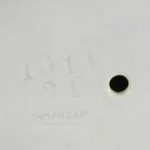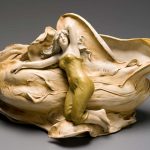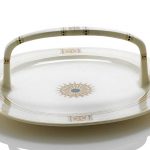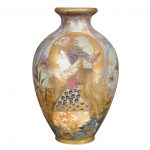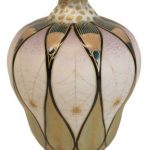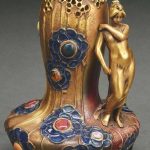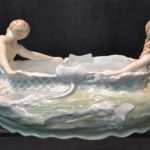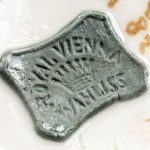Amphora was founded in 1892 by Hans and Carl Riesser, Edward Stellmacher and Rudolf Kessel and the company was awarded a prize at the World’s Columbian Exposition of 1893. In 1897, the firm began making art pottery vases showing elaborate Art Nouveau designs and was again recognised by awards at the St. Louis World’s Fair in 1904. In 1905, the company introduced a new mark to reflect new ownership, that of Riessel and Kessel after Stellmacher’s departure. Amphora wares were also sold in the United States by specialist shops including that of Louis Comfort Tiffany in New York, who appreciated the innovative hand crafted designs. Reference: Museum of Applied Arts and Sciences
Below are some examples and price guides of some Art Nouveau Amphora items including a jardiniere with a nymph / lady and an example of Amphora’s maker’s mark
Amphora Impressed Maker’s Mark
This jardinière offers one of the most striking designs created by Amphora, a Bohemian factory which was well known in Europe in the early 1900s for its decorative porcelain and earthenware, as well as for innovative glazes. It was designed in the Art Nouveau style (or Secession as the style was known in central Europe), the mainstream decorative style of design, visual arts and architecture between the early 1890s and the outbreak of the World War I in 1914.
Reference: Museum of Applied Arts and Sciences
An Amphora earthenware cake plate, the design attributed to Chris van der Hoef 1908 – 1910 painted with geometrical motifs in ochre, green and black on a cream ground painted factory mark, no. 268.i. and R. diameter 29 cm
Sold for 1,250 EUR at Sotheby’s in 2008
Riessner, Stellmacher & Kessel Amphora Pottery Co. Allegory of Germany Portrait Vase From the Portrait Series, shape model no. 699, circa 1899-1903 In the Art Nouveau style, of ovoid form, decorated with a side profile of a woman with long brown hair wearing a medieval warrior helmet adorned with a Germanic eagle head and feathers, silhouetted with a golden halo. Height 16 1/4 inches. There are two prevailing thoughts as to the representation and symbolism of the portrait on this vase. According to Jan Mergl, co-author of Riessner, Stellmacher & Kessel, Amphora Ceramics from the House of Amphora 1890-1915 by Richard L. Scott, the woman depicted is an allegorical representation of one of the four prevailing European powers at the end of the 19th century: France, Germany, Austro-Hungary and Russia. This allegorical design is credited to Nikolaus Kannhauser, who was one of Amphora Pottery’s Co.’s head painters.
Sold for $16,250 (includes buyer’s premium) at Doyle in 2013
Amphora Austria Art Nouveau hand painted porcelain spider vase, circa 1890. Beautiful hand painted gilt spiderwebs with peacock feathers throughout. Reticulated designs to the neck. Amphora marks to the underside base. Weight Approx., 1 lb Measures Approx., 4.25 inches diameter x 6 inches height
Sold for $1,200 at Taylor & Harris in 2021
Amphora “Gres Bijou” vase with applied Art Nouveau figure of a woman. Amphora Austria mark, impressed “8168”. 10 – 3/4″ high. Illustrated in The House of Amphora, Scott, p. 189. Condition: (Mint). Dimensions: 10 – 3/4″ x 8″ x 8″
Sold for $6,000 at Dan Morphy Auctions in 2020
